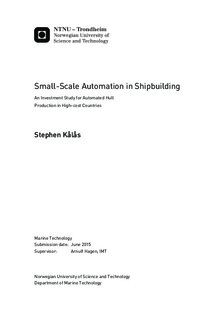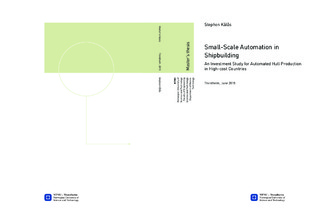| dc.description.abstract | The globalized market enforces a great cost pressure on all the shipbuilding actors. Norwegian yards, representing countries with high local wages and prices, is under pressure to make changes if they want to keep up with the competition. Historically, ship owners have been willing to pay the extra price for Norwegian ships, given the reputation of good quality and deliverability, but this could change in the near future. Asian shipyards are becoming more skilled at building increasingly complex vessels. They have access to low-cost labour, and can usually offer a better price on the ships compared to Norwegian designs and builds.
The overall goal of this thesis is to investigate if modern automation technology can be applied in hull building to increase efficiency, and level the labour-cost differences between high labour-cost countries and low labour-cost countries. The framework for the thesis is a semi-integrated yard in a high labour-cost country who buys completed hulls abroad and now wish to make a strategic move towards becoming a fully integrated yard, performing more of their own steel work.
The hypothesis is that it will be too expensive to hire manual labour to perform the vast amount of construction work needed to complete a hull. It is a very labour-heavy task, and getting a large enough qualified workforce can prove difficult. The aim is to investigate if modern automation technology can be a viable investment to reach the goal of taking back more steel work of the hull production. The focus will be on identifying realistic operations to automate, and investigate what impact it has on the production efficiency.
A literature review focusing on the hull building process and modern automation technology identified several intelligent robotic configurations that could potentially increase the hull building efficiency, as well as eliminating the hazards associated with manual work task operation. In later years, the larger Asian yards have focused on building specialized robots for application at the shipyards. Although prototypical, they show great test results.
To evaluate the different elements affecting the investment decision regarding automation technology, a model is developed. The model can be used as a tool in the quantitative decision-making between the two options: invest in automation technology to make own hulls, or keep buying hulls abroad. The model depicts simple calculations that shed light on where the largest potential for improvement through automation lies, and whether or not the investment pays off over time. It consist of six basic steps:
Step 1: Establish case data
Step 2: Map process time consumption
Step 3: Perform maximum investment calculations
Step 4: Evaluate investment by Net Present Value
Step 5: Sensitivity analysis
Step 6: Scenario weighting with Quantitative Strategic Planning Matrix
Each step builds from the preceding step and applies the newly retrieved information into the next analysis.
The model is applied to a case study to test its validity. The case study is based on key figures publically available, as well as some qualified estimates. This study focus on the building of semi-advanced Platform Supply Vessels with a typical length of 75-90 meters, breadth of 17-20 meters and 3500 tons of steel weight. The case study yard can manage a throughput of four vessels of this kind each year.
The results from applying the model to the case study shows that modern automation technology can contribute to an increase in the hull building efficiency. This increased efficiency result in valuable time saved, and justifies a substantial investment in automation technology for each of the stages described in the hull building process.
In addition to increasing efficiency, the automation technology introduce several advantages that cannot be measured directly in monetary values. These elements are crucial to include in the decision-making process, as they can affect the long-term reputation of the given yard. Only by combining the conclusions from the qualitative and quantitative analysis is it possible to comprehend the total investment value. | |

